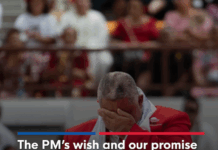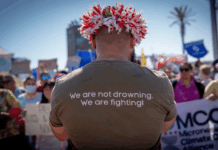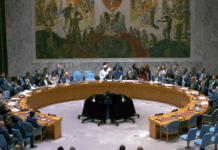
Report from Common Dreams
“The governments of the world may rule the world but they don’t own the world.” In this analysis, Jeremy Brecher reflects on the climate change struggle since COP21 in Paris almost two months ago.
In December of 2015 – the earth’s hottest year since recordkeeping began — 195 nations met in Paris to forge an agreement to combat global warming. The governments of the world acknowledged their individual and collective duty to protect the earth’s climate — and then willfully refused to perform that duty. What did they agree to, and how should the people they govern respond?
The 195 nations meeting in Paris unanimously agreed to the goal of keeping global warming “well below 2 degrees Celsius” and to pursue efforts “to limit the increase in temperatures to 1.5 degrees Celsius.”
Despite that goal, the Paris agreement also permits the greenhouse gas (GHG) emissions that cause global warming to continue rising.
Under the Paris agreement, governments put forward any targets they want – known as Intended Nationally Determined Contributions (INDCs) – with “no legal requirement dictating how, or how much, countries should cut emissions.”[1] These voluntary commitments don’t come into effect until 2020 and generally end in 2025-2030.
Today there are 400 parts per million (ppm) of carbon in the atmosphere, far above the 350 ppm climate scientists regard as the safe upper limit. Even in the unlikely event that all nations fulfill their INDC pledges, carbon in the atmosphere is predicted to increase to 670 ppm by the end of this century.[2] The global temperature will rise an estimated 3.5 degrees Celsius (6.3 degrees Fahrenheit) above pre-industrial levels.[3] For comparison, a 1-degree Celsius increase has been enough to cause all the effects of climate change we have seen so far, from Arctic melting to desertification. In short, the agreement authorizes the continued and even increased destruction of the earth’s climate.
US negotiators were adamant that the agreement must not include any binding restrictions on emissions. Secretary of State John Kerry told fellow negotiators that he “wished that we could include specific dates and figures for emissions cuts and financial aid” to developing countries, but “this could trigger a review by the US Senate that could scuttle the entire agreement.”[4] When US lawyers discovered a phrase declaring that wealthier countries “shall” set economy-wide targets for cutting their GHG pollution, Kerry said, “We cannot do this and we will not do this. And either it changes or President Obama and the United States will not be able to support this agreement.” “Shall” was changed to “should” without so much as a vote.[5]
The breathtaking gap between the Paris agreement’s aspiration to hold global warming below 2 degrees Celsius and the agreement’s actual commitments is indicated by an analysis by Climate Interactive and MIT Sloan. The current US pledge to drop GHG emissions 26 percent below 2005 levels by 2025, along with the pledges of other countries, will lead to a global temperature increase of 3.5 degrees Celsius (6.3 degrees Fahrenheit) above pre-industrial levels. To reduce warming to 1.8 degrees Celsius (3.2 degrees Fahrenheit) will require the US to increase its INDC from 26 percent below 2005 levels to 45 percent by 2030, and for other countries to make comparable reductions.[6]
Under the Paris agreement countries will monitor their emissions and reconvene every five years starting in 2023 to report on the results and perhaps ratchet up their INDCs. This has been characterized as creating a “name-and-shame” system of global peer pressure, “in hopes that countries will not want to be seen as international laggards.”[7]
On the last day of the Paris summit, a panel of leading scientists evaluated what would be necessary to achieve its targets. Prof. Hans Schellnhuber of the Potsdam Institute for Climate Impact Research said that to reach the 2-degree target the world would have to get CO2 out of its system by 2070. To reach the 1.5-degree target it would have to eliminate CO2 emissions by 2050. Johan Rockstrom of the Stockholm Resilience Center said that for any chance of reaching 1.5 degrees, the richest nations need to reach zero fossil fuel use by 2030.[8]
Fossil freeze
Meanwhile, fossil fuel projects are multiplying – and many are meeting effective resistance both through both legal means and through civil disobedience. Last year, after a seven-year struggle, President Obama turned down a permit for the Keystone XL pipeline. Collateral struggles have terminated other Canadian tar sands projects worth $17 billion. Scotland, Wales, France, Tasmania, as well as such states as New York have banned natural gas fracking. On the West Coast, four of the six proposed giant coal ports have been cancelled, and the future of the other two hang in the balance. In southern India, a six-year campaign has stopped a huge coal plant.[9]
In an article last spring, Bill McKibben acknowledged that “fighting one pipeline at a time, the industry will eventually prevail.” But he argued that conditions are ripening for a “fossil freeze” – a halt to all new fossil fuel development.[10] The fossil fuel industry itself is in crisis, finding that its new projects have become unprofitable all over the world – a crisis aggravated by the spread of the view that fossil fuel energy is on the way out and by the divest/invest movement, which announced in Paris that 500 institutions with assets of $3.4 trillion have agreed to some form of fossil fuel divestment.[11] Over the last six years solar panels have become 75 percent cheaper and the cost of installation is predicted to fall 40 percent in the next two years. Denmark now gets 40 percent of its electricity from wind power; Bangladesh plans to run entirely on solar energy by 2020. The climate protection movement combined with the new economics of energy are “reshaping the consensus view about how fast a clean energy future could come.[12]
State and local policy is increasingly rejecting new fossil fuel infrastructure based on the greater economy of grid modernisation, distributed energy, energy efficiency, and the falling cost of renewables. In many localities advocates for those policy changes could be tacit or explicit allies of a fossil freeze campaign.
Of course, there is a common-sense objection to proposals to “leave fossil fuels in the ground”: Won’t billions of people soon freeze to death in the dark? But a focus on shifting new investment from fossil fuels to clean energy provides a common-sense answer: Why should we spend one more penny for costly, outmoded, environment-destroying fossil fuel infrastructure when new clean energy technology is not only climate-friendly but cheaper?
Another concern is that a fossil freeze will threaten the jobs of those workers who produce and use fossil fuel and the construction workers who build fossil fuel infrastructure. A fossil freeze campaign will need a jobs program that includes both a just transition for workers who will be affected by the freeze and a way to take advantage of the transition to fossil-free energy to create millions of jobs for all kinds of workers – especially those who have long been the victims of discrimination and exclusion from good jobs.[13]
Added jobs
Late last year the Labor Network for Sustainability (LNS) and 350.org issued a report “The Clean Energy Future: Protecting the climate, creating jobs, and saving money.”[14] It shows that the US can reduce GHG emissions 80 percent by 2050 – while adding half-a-million jobs per year and actually saving money compared to business-as-usual fossil fuel energy. Most of the added jobs will be in manufacturing and construction.
The plan does not depend on any new technical breakthroughs to realize these gains, only a continuation of current trends in energy efficiency and renewable energy costs. It is based on the conversion of all gasoline-powered light vehicles and most space heating and water heating to 100 percent renewable electricity. It includes an orderly phasing out of coal and nuclear energy and a gradual reduction in the burning of natural gas.
In addition to such national plans, campaigns against local fossil fuel infrastructure need to propose specific alternatives for the pipelines, plants, and other facilities they are trying to block or close. These need to address both consumers’ need for energy and workers’ need for jobs. An example: When last year a campaign initiated by Baltimore high school students blocked a large incinerator project, the students organised a celebratory Concert for Fair Development highlighting proposals for a solar farm on the site, zero-waste reuse and recycling industries, and local agricultural initiatives.[15]
Breaking free
Near the close of the Paris climate talks, 350.org, Greenpeace, and other organizations announced escalated actions worldwide in May 2016. Building on the burgeoning on-the-ground resistance to new fossil fuel infrastructure, “Break Free From Fossil Fuels” aims to “accelerate a global energy transformation” away from fossil fuels.[16]
Actions in more than a dozen countries from the US to Turkey and from South Africa to Australia will “shut down the world’s most dangerous fossil fuel projects and support the most ambitious climate solutions.” Such civil disobedience will “reflect the scale and urgency of this crisis in a way that governments can no longer ignore.”[17] And it will show the fossil fuel industry that it will “no longer benefit from the consent of the people.”[18]
Break Free from Fossil Fuels could serve as a proving ground for a Fossil Freeze campaign.
Toward a global climate insurgency
The Paris climate agreement doesn’t prevent one molecule of GHG from being put in the atmosphere, but it may provide additional justification for civil disobedience actions like Break Free from Fossil Fuels and a Fossil Freeze.
In Paris, the governments of the world made a promise to the people of the world – and immediately betrayed it. On the one hand, all these governments, including the US, agreed that “climate change represents an urgent and potentially irreversible threat to human societies and the planet” and that “deep reductions in global emissions will be required.” On the other hand, they emphasised “the significant gap” between the “aggregate effect of Parties’ mitigation pledges in terms of global annual emissions of greenhouse gases by 2020” and “aggregate emission pathways consistent with holding the increase in the global average temperature to well below 2 °C above pre-industrial levels and pursuing efforts to limit the temperature increase to 1.5 °C.”[19] Stripped of the jargon, this says they recognize that their current policies are aggravating that “irreversible threat” and acknowledge the inadequacy of their efforts to halt it.
The call to Break Free from Fossil Fuels asks us to imagine “tens of thousands of people around the world rising up” to take back control of their own destiny; “sitting down” to “block the business of government and industry that threaten our future;” conducting “peaceful defense of our right to clean energy;” making sure that “the promises are kept.” That is surely what it will take to reverse climate change.
Such a “rising up” amounts to a global nonviolent insurgency – a withdrawal of consent from those who claim the right to rule manifested in a selective refusal to accept and obey their authority.[20] When citizens interfere with a pipeline, power plant, or other fossil fuel infrastructure project to demand a transition to a clean energy future they are committing no crime, but responding to an extreme emergency and to corporations that are criminally negligent and criminally complicit in perpetrating that irreversible threat. They are showing that the fossil fuel industry “will no longer benefit from the consent of the people.”
They are giving the same message to the governments that are aiding and abetting the fossil fuel industry. After all, it is the very governments that approved the Paris Agreement that are permitting and even encouraging the continued and expanded burning of fossil fuels. Every new fossil fuel infrastructure project in the world is authorised by permits issued by one government or another. Two-thirds of the GHG emissions in the US are emitted pursuant to government-issued permits.[21] And it is governments that send police to arrest, try, and sometimes brutalise those who are trying to protect the planet and enforce the law.
The governments of the world may rule the world but they don’t own the world – that is the common property of humanity. The Paris Summit was in effect a conspiracy of the world’s governments to rob the world’s people and their posterity of their common inheritance. Those governments acknowledged the devastation they are causing, but refused to be accountable to each other for correcting it. So now they need to be made accountable to the world’s real owners.
Reference notes here













































